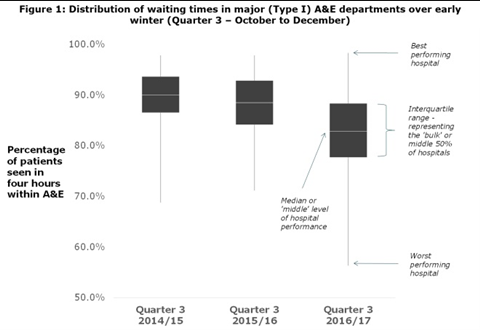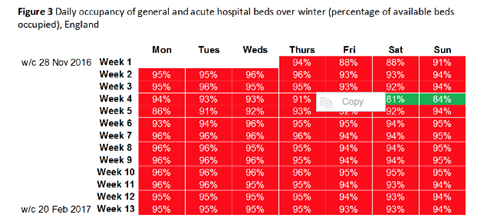Siva Anandaciva argues that we are now in danger of losing the substantial progress made in A&E performance more quickly and deeply than feared
No one would ever claim that winter in the NHS is easy. Our most recent Quarterly Monitoring Report (QMR) duly paints a picture of accident and emergency departments that are struggling to cope as the health needs of patients become both more complex and more acute.
The recent publication of the latest set of daily performance reports for the traditionally busy winter months of 2016/17 now allows us to look back and take a wider view of how the NHS held up this winter.
Although there has been considerable discussion of new potential approaches to measuring A&E performance, the standard remains for 95 per cent of patients to be discharged, admitted or transferred within four hours of arrival in A&E.

Source: A&E Attendances and Emergency Admissions, NHS England
However, when we look at the distribution of A&E waiting times across major (or ‘Type I’) A&E departments over the early winter months it is clear that the ‘bulk’ of hospital performance has moved sharply downwards. This reflects how nationally over October to December of 2016/17 only 81.9 per cent of patients were seen within four hours, compared to 87.4 per cent just one year earlier (Figure 1).
But perhaps even more worryingly, Figure 1 shows how the range of performance is also far more variable this year across different hospitals. Over the previous two years only one hospital saw fewer than 70 per cent of patients within four hours, and yet in 2016/17 over 10 hospitals were performing at this level – with the lowest performing hospital seeing only 56.3 per cent of patients within four hours.

Source: A&E Attendances and Emergency Admissions, NHS England
While the prime minister initially appeared to downplay this winter’s pressures, describing them as ‘not unusual’, it is clear that A&E departments have experienced their most difficult winter for many years.
After looking at the longer term trend in waiting times for major A&E departments it seems clear that there is a new ‘normal’ for A&E performance. Despite the heroic efforts of frontline staff, waiting times in A&E over summer in 2016/17 year were worse than early winter last year and as one hospital CEO said to me: ‘We are starting to lose our calibration of what good likes like.’
Usual suspects
The improvements in A&E performance over the last decade were incredibly hard won, with investments in A&E staffing levels, increases in the physical capacity of A&E departments and improvement in how services were planned and designed to ensure the safe and effective flow of patients throughout hospital. We are now in danger of losing this substantial progress more quickly and deeply than was previously feared.
So why has performance deteriorated so rapidly and what made this year so much worse? If anything, there has been a noticeable absence of the usual suspects that cause ‘winter pressures’.
The incidence of winter vomiting bugs like norovirus – which can rapidly close entire wards and reduce the number of beds available for patients awaiting admission from A&E – is lower than in previous years.
And the relatively dry and mild winter weather has not led to a significant increase in demand due to respiratory conditions such as influenza-like illness. Although it may not feel like it, we had some of the conditions for a good winter in A&E this year and yet performance was still incredibly challenged.
This all suggests there is a deeper capacity challenge now facing A&E departments. I recently spoke to a hospital Chief Operating Officer whose A&E department was built to see 60,000 patients each year and is now routinely seeing over 100,000.
For departments like his, the recent emphasis on redirecting A&E patients with minor medical conditions to primary care may help take some pressure off.
But as finance directors in our QMR survey point out, it is the lack of available hospital beds due to a potent mix of rising demand from sicker and more complex patients, social care cuts, flat-lining hospital budgets and increasing delays in transferring patients out of hospital that seems to be the primary cause of long waits in A&E.
Research dating back to the National Beds Inquiry 15 years ago, and even further back to Erlang’s work on queuing theory, indicate that when more than 85 per cent of beds are occupied hospitals will encounter problems in handling emergency admissions.
Figure 3 below shows that there were only three days when the NHS had this level of spare capacity – and unsurprisingly these included the atypical days of Christmas Eve and Christmas Day. In previous years bed occupancy levels have traditionally eased as we start to enter the spring and summer months. But this year the pressure on NHS beds may well be sustained as hospitals try to make up for lost ground by rescheduling the many surgical operations that were cancelled due to pressures over winter.

Source: Winter Daily Situation Reports, NHS England
So if the problems in A&E performance are both structural and system-wide across health and social care, where does this leave us?
Firstly, although there is much to learn from how trusts like Luton and Dunstable University Hospital have redesigned A&E services to maintain low waiting times, the solutions to A&E pressures are now unlikely to be solely within the gift of individual hospitals.
Future proposals to support struggling A&E departments may need to follow the whole system ethos of the success regime and sustainability and transformation plans, rather than the institution focus of ‘special measures’.
Secondly, there may be no quick fixes to this underlying structural problem. If there is indeed more funding for social care in the upcoming Spring budget it will provide much needed short term relief for pressured services.
But in local areas where social care capacity has been rapidly stripped back, and where residential and care homes have already been closed and sold, it will take time for additional funding for social care to materially impact on performance in A&E – if at all.
Finally we need to recognise that we are not out of the winter woods yet. Over 70 per cent of finance directors in our recent QMR survey opened additional hospital beds and increased the number of clinical staff to cope over winter this year.
But if we can’t definitely point to norovirus, flu and respiratory distress as the causes of longer waits in A&E this winter, then we would be wrong to assume that bed occupancy in hospitals will become more manageable and A&E performance will bounce back as winter recedes.
It may be the case that some of these ‘winter’ escalation beds stay open well into the summer months, and that A&E departments now must cope with a winter that never seems to end.
Siva Anandaciva is chief analyst at the King’s Fund



























1 Readers' comment